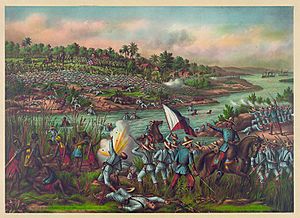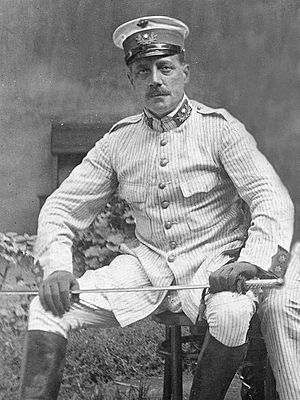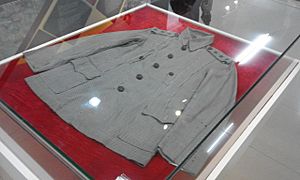Rayadillo facts for kids
Rayadillo was a special blue-and-white striped fabric. It was made from cotton or flannel. This material was used to create military uniforms for Spanish soldiers who served in colonies far away from Spain. They wore these uniforms from the mid-1800s to the early 1900s.
The British called these uniforms "pyjamas" because they looked a bit like sleeping clothes! Soldiers in warm, tropical Spanish colonies, like those in the Spanish East Indies (which included the Philippines), and later in Spanish Morocco and Spanish Guinea, often wore them.
The rayadillo uniform became very well-known after the Spanish–American War. Later, the Philippine Army also started using it. It was even the summer uniform for the regular army in Spain until 1914.
The word rayadillo comes from Spanish and means "striped material." In the mid-1800s, people called this fabric hilo listado azure, which means "blue striped thread." By the end of the century, it was known as dril azul rayado, or "blue striped drill fabric."
At first, the stripes on rayadillo fabric were light blue and far apart. But later, uniforms from the 1890s had thinner, darker blue stripes. These were sometimes called mil rayas, meaning "a thousand stripes." From a distance, rayadillo uniforms looked either very light blue or blue-gray.
The Philippine Revolutionary Army, led by Emilio Aguinaldo, also used this fabric for their uniforms. They wore them during the later parts of the Philippine Revolution and the Philippine–American War.
Along with pith helmets, which were also first used by the Spanish in Southeast Asia, the rayadillo uniform became a strong symbol of colonial rule. In the Philippines, the rayadillo uniform is closely connected to the First Philippine Republic and the Philippine-American War (1899-1902).
Today, rayadillo patterns have made a comeback in fashion. You can see them in everyday clothes, especially trousers, which are still sometimes called mil rayas.
Contents
What did Rayadillo uniforms look like?
Military uniforms made from rayadillo came in a few different styles.
Spanish Empire uniforms
The Guerrera Jacket
The guerrera was a campaign jacket worn as part of the rayadillo uniform. It was made of dark blue flannel. This jacket had two pockets on the chest with flaps and was fastened with seven metal buttons down the front. Its design was based on the official uniform jacket for Spanish infantry soldiers, which was approved in 1886.
Spanish troops stationed in the Philippines, Cuba, and Puerto Rico wore the guerrera. The guerrera jackets made for the Philippines were different from those in Cuba and Puerto Rico. They had a standing collar and buttons that were hidden behind a flap. This uniform was given to soldiers from 1891 to 1898.
The Guayabera Tunic
The guayabera was a tunic inspired by a traditional Cuban work jacket. This tunic had pleats (folds) running down the front and back. It also featured four large pockets on the lower part of the tunic. Sometimes, its buttons were hidden. The buttons were usually made of bone, and sometimes the buttons on the shoulder straps and pockets were covered with rayadillo fabric. A thin white cotton lining was found inside the shoulder area. Pictures from that time suggest these uniforms were used from about 1896 to 1898.
Philippine Republic uniforms

The Filipino rayadillo military tunic was created by what would become the First Philippine Republic during the Tejeros Convention. It had two wide strips of matching fabric on the front, from the shoulders down to the bottom. These strips covered horizontal chest pockets, which had vertical flaps and buttons. The buttons were either made of brass or covered with rayadillo fabric. Brass buttons sometimes had a "mythological sun" design.
Officers' tunics had slits on the sides. This allowed them to attach a holster for a handgun and a sword to a belt worn under the tunic. Infantry officers wore blue pants with a black stripe down the side. Cavalry officers wore red trousers with black stripes.
The famous artist Juan Luna is given credit for designing this uniform. His brother, General Antonio Luna, asked him to do it. Juan Luna also designed the collar badges for the uniforms, which showed what branch of the military a soldier belonged to, such as Infantry, Cavalry, Artillery, Sappers, and medical staff. Some historians believe Juan Luna might have based the tunic on the English Norfolk jacket, as the Filipino version was not a copy of any Spanish uniform. Another idea is that Emilio Aguinaldo and his friends, while in exile in Hong Kong, had rayadillo uniforms made in this popular sports style.
How was Rayadillo used later?
Spanish soldiers continued to wear rayadillo clothing a lot into the early 1900s. They wore it during active service in Morocco until 1911, when a new khaki uniform was adopted. By then, the rayadillo uniform was mostly white with thin blue stripes. It was the summer uniform for all parts of the Spanish mainland army until 1914.
In the Philippines, veterans of the Philippine Revolution and the Philippine-American War often wore Norfolk-style rayadillo uniforms during the American period and into the early years of the Republic. This was part of their heritage.
Today, rayadillo-inspired uniforms are used by the Armed Forces of the Philippines as part of their ceremonial uniforms for national events, especially on Philippine Independence Day. For example, the Philippine Army's Escort and Security Battalion uses it as a main formal uniform. Other soldiers wear straw hats, while officers wear pith helmets. In 2005, General Cardozo M. Luna, who was the leader of the Philippine Military Academy, brought back the rayadillo material for the cadets' dress uniform. This replaced the uniform that was inspired by the United States Military Academy at West Point. Rayadillo-style uniforms are also worn by staff in the Presidential Security Group.
Images for kids
-
Soldiers wearing rayadillo uniforms and pith helmets in Spanish North Africa, 1909.
See also
 In Spanish: Rayadillo para niños
In Spanish: Rayadillo para niños




